History of Pakistan
Interesting Facts about CNIC Card Information OR Pakistani ID Card / NADRA

All Pakistani are issued Computerized National Identifi cation Card (CNIC) by the Government of Pakistan as their Identity card.
National Database and Registration Authority (NADRA) is the official Authority to issue, CNIC, Passports, Marriage Certificates, Death Certificates and other verification documents in Pakistan for more News.
Every adult in Pakistan is compulsory to register himself with NADRA to obtain a CNIC number. CNIC number looks like 35101-1234567-8. Each part here contains information. Most of us don’t know about this information.

Here’s the CNIC Card Information behind a CNIC card number.
- In First of CNIC Card Information Number, (35101) first number (in this case, 3) represent the Province Number, the number of Punjab is 3 so the CNIC number of Punjabians will start from 3.
- The second number (in this case, 5) represents the division number, Lahore is a division and its number is 5
- The remaining 3 numbers represents District number and serial number.
- The numbers in middle is a unique number given to you.
- The Last Number represents the Gender of the CNIC holder. The ODD number (1,3,5,7,9) at end will show MALE gender. It means if the last number of a CNIC is 1,3,5,7 or 9 then it will of a Male.
- If the Last number is an even number (0,2,4,6 or 8) it will be of a Female.
I hope you find this information useful and will share it with others, don’t forget to follow/like and support INCPAK on social media platforms.
Please Share your feedback
Business
Unveiling the Elegance: Explore Bugatti’s Black Car and Its Price in Pakistan

Bugatti’s costs nearly PKR 3 billion in 2019 and Now PKR 109.65 crore
Get ready to be amazed by the sheer elegance of Bugatti’s black car! This stunning vehicle is a true masterpiece of engineering and design, offering a luxurious and thrilling driving experience like no other. In this article, we will delve into the world of Bugatti and explore the price of their black car in Pakistan.

Bugatti is renowned for producing some of the most exquisite and high-performance cars in the world. With their sleek and aerodynamic designs, powerful engines, and avant-garde features, Bugatti cars are a symbol of luxury and exclusivity. The black car from Bugatti exemplifies this brand’s commitment to excellence, with its sleek black exterior and opulent interior.
If you’re a car enthusiast or simply appreciate the finer things in life, you won’t want to miss the chance to discover the allure of Bugatti’s black car. We will also explore the price of this extraordinary vehicle in Pakistan, giving you a glimpse into the world of elite automotive luxury.
Join us as we unveil the elegance of Bugatti’s black car and unravel the mystery behind its allure. Get ready to be captivated by the beauty and performance of this extraordinary vehicle.
The allure of luxury cars
Luxury cars have always held a special place in the hearts of automotive enthusiasts. These vehicles are not just modes of transportation; they are works of art, meticulously crafted to provide an unparalleled driving experience. From their sleek designs to their powerful engines, luxury cars embody elegance and sophistication. And when it comes to luxury cars, Bugatti is a name that stands above the rest.

Bugatti’s Black Car: A symbol of elegance
Bugatti’s black car is the epitome of elegance and style. With its sleek and aerodynamic design, this vehicle turns heads wherever it goes. The black exterior gives it a striking and sophisticated look, exuding a sense of power and luxury. But it’s not just the exterior that sets this car apart; the interior is equally as impressive.
Step inside Bugatti’s black car, and you’ll be greeted by a world of opulence. From the finest leather seats to the meticulously crafted dashboard, every detail has been carefully considered to provide the utmost comfort and luxury. The black car truly represents the pinnacle of automotive design and craftsmanship.
Features of Bugatti’s Black Car
Bugatti’s black car is not just a pretty face; it is packed with advanced features that take the driving experience to a whole new level. From cutting-edge technology to innovative safety features, this car has it all. Some of the standout features include:
1. Powerful Engine: At the heart of Bugatti’s black car is a powerful engine that delivers mind-blowing performance. With its exceptional horsepower and torque, this vehicle can go from 0 to 60 mph in just a matter of seconds.
2. Aerodynamic Design: The sleek and aerodynamic design of Bugatti’s black car not only enhances its visual appeal but also improves its performance. The car glides effortlessly through the air, reducing drag and increasing overall efficiency.
3. Intuitive Infotainment System: Bugatti’s black car is equipped with an intuitive infotainment system that seamlessly integrates with your smartphone. Stay connected and entertained while on the road with features like Bluetooth connectivity, satellite radio, and navigation.
4. Advanced Safety Features: Bugatti takes safety seriously, and the black car is no exception. With features like adaptive cruise control, lane departure warning, and blind-spot monitoring, you can drive with confidence knowing that you’re protected.
Performance and specifications
Bugatti’s black car is not just about looks; it is a performance beast. With its powerful engine and advanced technology, this vehicle delivers a driving experience like no other. Here are some of the key performance and specifications:

– Engine: Bugatti’s black car is powered by a beastly engine that produces an astounding amount of horsepower and torque. This allows the car to accelerate rapidly and reach breathtaking speeds.
– Top Speed: The black car has an impressive top speed that will leave you in awe. With its aerodynamic design and powerful engine, it can reach speeds that few other cars can match.
– Acceleration: The black car can go from 0 to 60 mph in a matter of seconds, providing an exhilarating and adrenaline-pumping experience.
– Handling: The car’s advanced suspension system and precise steering make it a joy to drive. It handles corners with precision and offers a smooth and comfortable ride.
The history of Bugatti
To truly appreciate Bugatti’s black car, it’s essential to understand the rich history behind the brand. Bugatti has been at the forefront of automotive innovation for over a century, with a legacy that dates back to the early 1900s. Founded by Ettore Bugatti, the brand quickly gained a reputation for producing some of the most luxurious and high-performance cars of its time.
Bugatti’s cars were not only known for their exquisite design but also for their exceptional performance. The brand dominated the racing world in the 1920s and 1930s, winning numerous championships and setting records that still stand today. Even after a brief hiatus, Bugatti returned to the automotive scene in the 1990s with the iconic Bugatti Veyron, which took the world by storm.
Bugatti’s Black Car in Pakistan
Now, let’s turn our attention to Bugatti’s black car in Pakistan. This luxurious vehicle has become a symbol of status and prestige among the elite in the country. Owning a Bugatti’s black car is a statement of wealth and sophistication, and it is not surprising that demand for this vehicle is high.
The black car from Bugatti has garnered a loyal following in Pakistan, with enthusiasts and collectors eagerly waiting for the opportunity to get their hands on one. However, due to its limited production and exclusive nature, the black car is not readily available for purchase. Only a select few will have the privilege of owning this extraordinary vehicle.
Price and availability in Pakistan
When it comes to the price of Bugatti’s black car in Pakistan, it’s important to note that this vehicle is not for the faint of heart. With its luxurious features and exceptional performance, the black car comes with a hefty price tag. The exact price may vary depending on customization options and additional features, but expect to pay millions of dollars for this exclusive vehicle.
As for availability, Bugatti’s black car is a rare gem. The limited production ensures its exclusivity, making it even more desirable among collectors and enthusiasts. If you’re lucky enough to find one for sale, be prepared to act quickly, as these cars tend to sell out fast.
Owning a Bugatti’s Black Car: Is it worth it?
Owning a Bugatti’s black car is a dream for many, but is it worth the investment? The answer to that question depends on your personal preferences and financial situation. If you have the means and desire to own one of the most exclusive and luxurious cars in the world, then the black car is undoubtedly worth it.
However, it’s important to consider the practicalities of owning such a vehicle. The maintenance and upkeep costs can be substantial, and finding qualified technicians who can work on Bugatti cars may be a challenge. Additionally, the limited availability of spare parts may result in longer wait times for repairs.
Conclusion: Experience the epitome of luxury with Bugatti’s Black Car
In conclusion, Bugatti’s black car is a true masterpiece of engineering and design. Its elegant and sleek exterior, combined with opulent interiors and advanced features, make it a symbol of luxury and exclusivity. This extraordinary vehicle represents the epitome of automotive luxury, offering a driving experience that is unparalleled.
While the price of Bugatti’s black car in Pakistan may be out of reach for most, it’s still worth exploring the allure and beauty of this extraordinary vehicle. Whether you’re a car enthusiast or simply appreciate the finer things in life, Bugatti’s black car is sure to captivate your imagination.
So, get ready to be enthralled by the elegance and performance of Bugatti’s black car. While owning one may be a distant dream for most, appreciating its beauty and craftsmanship is an experience in itself. Embrace the allure of Bugatti’s black car and immerse yourself in the world of automotive luxury like never before.
Remember, luxury knows no bounds, and Bugatti’s black car is the perfect embodiment of that.
Content
History of the Israel and Palestine conflict

“It’s not just about land, but it’s about having the right to self-determination,” said Dr. Serpil Atamaz, history professor at Sacramento State.
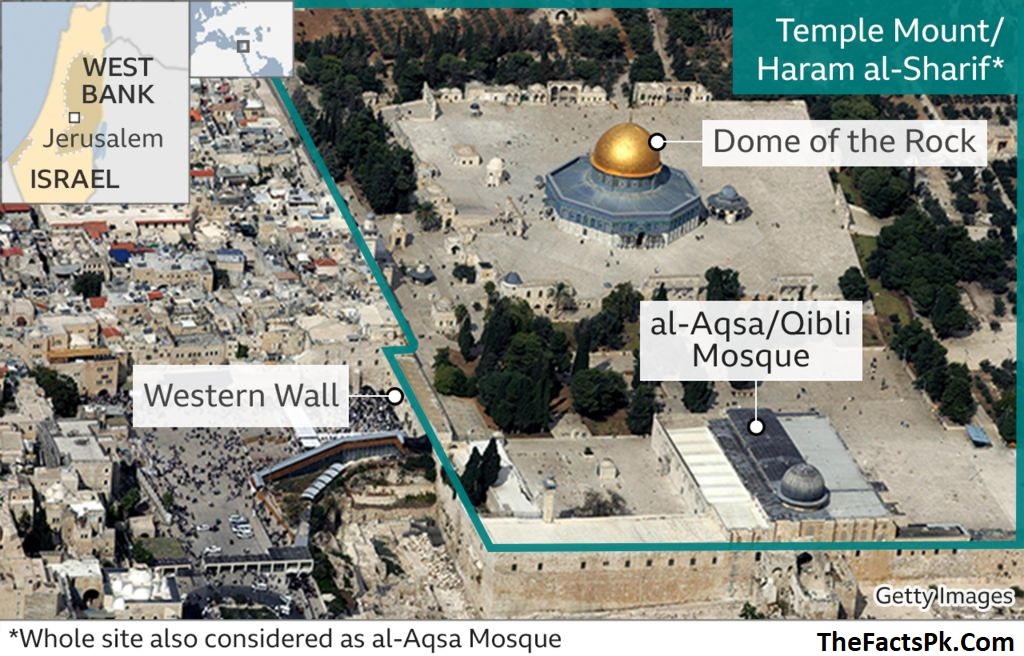
SACRAMENTO, Calif — The Israel and Palestine conflict is complex. It’s rooted in national, political, territorial, cultural and religious factors. Israelis and Palestinians both want the same thing: land.
Israel and Palestine conflict
“One side has a state, the other one does not,” said Dr. Serpil Atamaz, professor in the Department of History and Director of the Middle East and Islamic Studies Program at California State University, Sacramento. “It’s not just about land, but it’s about having the right to self-determination. This is not a conflict between Jews and Muslims or Jews or Arabs. It doesn’t go back to the biblical times or the Old Testament at all. This is relatively a modern conflict.”
The origins of the Israel and Palestine conflict can be traced back to the late 19th century. The Ottoman Turkish Empire ruled a large portion of the Middle East from 1516 to 1917, including the land along the eastern Mediterranean. The region was religiously diverse, including Jews, Muslims, and Christians.
“Judaism emerged in the Middle East, Islam emerged in the Middle East, and Christianity emerged in the Middle East, Atamaz said. “They shared the same place for hundreds of years under the Ottoman Empire and there was no war. What changed in the late 19th and early 20th century? We have a Jewish nation. We have British colonialism. That kind of changed the dynamics in the region.”
The centuries-old Ottoman Empire fell after the Allied Powers defeated the Central Powers in World War I in 1918. Two years later, the League of Nations was established as an international organization to ensure world peace. In 1922, the League formally approved the decision to have Great Britain act as Palestine’s administrator.
“Palestine had been ruled by the Ottoman Empire for several centuries,” Atamaz said. “When the Ottoman Empire fell, and when Britain and France won the war, it became a British Mandate. It came under the British rule.”
According to the United Nations, the British Mandate for Palestine was meant to be temporary, only lasting until the League recognized Palestine as a fully independent nation. That point never was reached.
The U.N. also has noted that the British government had given assurances to Zionist organizations about creating a Jewish state in Palestine.
“Zionism was an ideology and a movement that aimed to establish a Jewish state in Palestine,” explained Atamaz. “According to the Zionists in Eastern Europe at the time, Jews constituted a nation. They were not just a religious group, but they were an ethnic group and they deserved their own state.”
The rise of religious and racist anti-Semitism led to a resurgence of pogroms in Russia and Eastern Europe in the late 19th century, stimulating Jewish immigration to Palestine from Europe. Simultaneously, a wave of Jews immigrated to Palestine from Yemen, Morocco, Iraq and Turkey. That’s all according to the American-Israeli Cooperative Enterprise (AICE), a nonprofit established in 1993 with a goal of strengthening ties between the U.S. and Israel.
Even though Zionism originated in Europe in the late 19th century, some believe its roots are in the historical attachment between Judiasm and the lands that made up Palestine, historically speaking. According to AICE, some Jews were motivated to immigrate to Palestine by “the centuries-old dream of the Return to Zion and a fear of intolerance.“
“In Europe, Jews were being discriminated against, persecuted, and harassed,” Atamaz said. “So, they said, we need to establish our own state to be safe and secure. They chose Palestine to do that.
“This was the age of nationalism. All these different nations and ethnic groups were demanding their own nation state and Jews did the same. However, there was a big problem because Palestine, where they wanted to create their state, was inhabited by an Arab majority who had been there for more than a thousand years.”
Local Arab leaders and organizations were against the Zionists’ goal of Jewish statehood. After the fall of the Ottoman Empire, Arabs were searching for an opportunity to either create their own state, or join a larger Arab entity.
“The Zionists knew that they needed to increase the number of Jews in the area so that they could have a claim on Palestine,” Atamaz said. “That’s where the second development comes in. In 1917, during World War One, Great Britain announced the Balfour Declaration, which is a turning point in the history of the Israeli-Palestinian conflict.”
The Balfour Declaration of 1917 provided for the creation of a Jewish state in Palestine. The declaration did not provide Palestinian Arabs with political or national rights, prompting Arabs to disapprove of the mandate and, over time, rebel.
“Great Britain supported the idea of a Jewish national home in Palestine,” Atamaz explained. “However, another problem was that, just two years ago, Great Britain made another promise to the Arabs living in the region. They said Palestine was going to be a part of an independent Arab state that was going to be established after the war was over.
“Under the British rule, there was Jewish migration to Palestine. The British rule allowed the Jews to come in, migrate to Palestine, settle in Palestine, and to purchase land in Palestine in spite of all the Arab resistance and opposition to it. There were increasing tensions and hostilities between the Jewish community and the Arab community in the region. A lot of Palestinians lost their homes and lost their jobs because of the Jewish emigration. Britain tried to satisfy both sides, which was really impossible because these two communities had different ideas and visions for this territory.”
British efforts to bring the Zionists and the Arabs together failed, ultimately, leading to the Arab Revolt of 1936. It was the first sustained violent uprising of Palestinian Arabs in more than a century. The British government appointed a commission to investigate a solution among Palestinian Arabs and Jews. In 1937, the Peel Commission recommended Palestine be partitioned into three zones: an Arab state, a Jewish state, and a neutral territory containing the holy places.
As the riots were ending, the British government issued the White Paper in 1939. It rejected the commission’s plan, stating it was “not feasible.” According to AICE, the document stated Palestine would be neither a Jewish state nor an Arab one, but an independent state to be established within ten years.
The White Paper also limited Jewish immigration in Palestine. Even though Palestine was closed off to Jews, they still desperately tried to immigrate to the region to escape Nazi-dominated Europe during World War II.
“In 1947, Britain decided to refer the matter to the United Nations as the violence escalated in the region,” Atamaz said. “The United Nations decided to form a Special Committee On Palestine – UNSCOP. This committee went to Palestine, talked to people, made some investigations, and they came up with a plan. This partition plan said that there were going to be two states in Palestine. There was going to be a Jewish state and a Palestinian state. This plan was not accepted by Arabs in Palestine because even though only a third of the population was Jewish and the Jews owned only 10% of the land in Palestine, they were given 55% of the territory. The Palestinians ended up with 45%, even though they were the majority at the time. However, the Jewish community had been preparing for statehood since they migrated to Palestine. They had already formed organizations and institutions that they needed for self-government.”

According to the National Army Museum, a leading authority on the British Army and its impact on society past and present, Britain gave up its mandate in 1948. The British Army departed from Palestine leaving the Jews and the Arabs to fight it out in the war that followed. The campaign had cost around 750 British military and police lives. On May 14, 1948, Israel was officially declared an independent state.
“When Britain announced that it was withdrawing its troops from the region, David Ben-Gurion, the first prime minister of Israel, declared the establishment of Israel as a new state in Palestine, which led to the first Arab-Israeli war because the neighboring Arab countries declared war on Israel to stop it from consolidating itself,” Atamaz said. “It ended with defeat for Arabs. Israel actually was able to even expand its territories.”
Under separate agreements between Israel and the neighboring states of Egypt, Lebanon, Transjordan, and Syria, these bordering nations agreed to formal armistice lines. In Israel, the war is remembered as the “War of Independence.” Israel gained some territory formerly granted to Palestinian Arabs under the United Nations resolution in 1947. Egypt and Jordan retained control over the Gaza Strip and the West Bank, respectively.
“Almost one million Palestinians were either forced to leave the region or had to flee because where they were living all of a sudden became Israel,” Atamaz explained. “To this day, Palestinians remember the war as ‘Nakba,’ ‘the Catastrophe,’ that led to the displacement of Palestinians. There were three more wars between Israel and different Arab countries. The War of 1967 is the most important one. At the end of this war, Israel gained a big victory. It occupied the remaining Palestinian territories. Whatever was left in the hands of the Palestinians became an occupied territory. This occupation was supposed to be temporary. It was regarded illegal by the United Nations. However, the occupation continues to this day. The West Bank, East Jerusalem and the Gaza Strip are occupied territories, which means they are still under Israeli occupation.”
History of Pakistan
History of Pakistan from perspective of the economy

Introduction History of Pakistan
Pakistan is a nation that has faced many challenges since its inception. One of the most pressing issues that Pakistan has grappled with over the years is its economy. From its early years as a newly-formed state to the present day, Pakistan has been forced to deal with a range of economic issues that have impacted its growth and development. In this article, we will explore the history of Pakistan from an economic perspective, examining the various regimes that have shaped the country’s economy. History of Pakistan with the perspective of the economy by thefactspk.com

Early years of Pakistan
Pakistan came into being in 1947, following the partition of India. The country was initially made up of two regions, East Pakistan (present-day Bangladesh) and West Pakistan (present-day Pakistan). At the time of independence, Pakistan was a predominantly agrarian economy, with the majority of the population working in agriculture. The country also had a limited industrial base, with most industries located in the western part of the country. The first decade of Pakistan’s existence was marked by economic growth, thanks in large part to the country’s focus on agriculture. Pakistan became known as a major producer of cotton, with its cotton industry accounting for a significant share of the country’s exports. In addition to cotton, Pakistan also produced other crops such as wheat, rice, and sugarcane.
However, despite the growth in the agricultural sector, Pakistan’s overall economy remained fragile. The country faced a number of challenges, including a shortage of foreign exchange reserves and a lack of industrial development. This led to a number of economic policies being implemented in an attempt to promote growth and development.History of Pakistan with the perspective of the economy by thefactspk.com
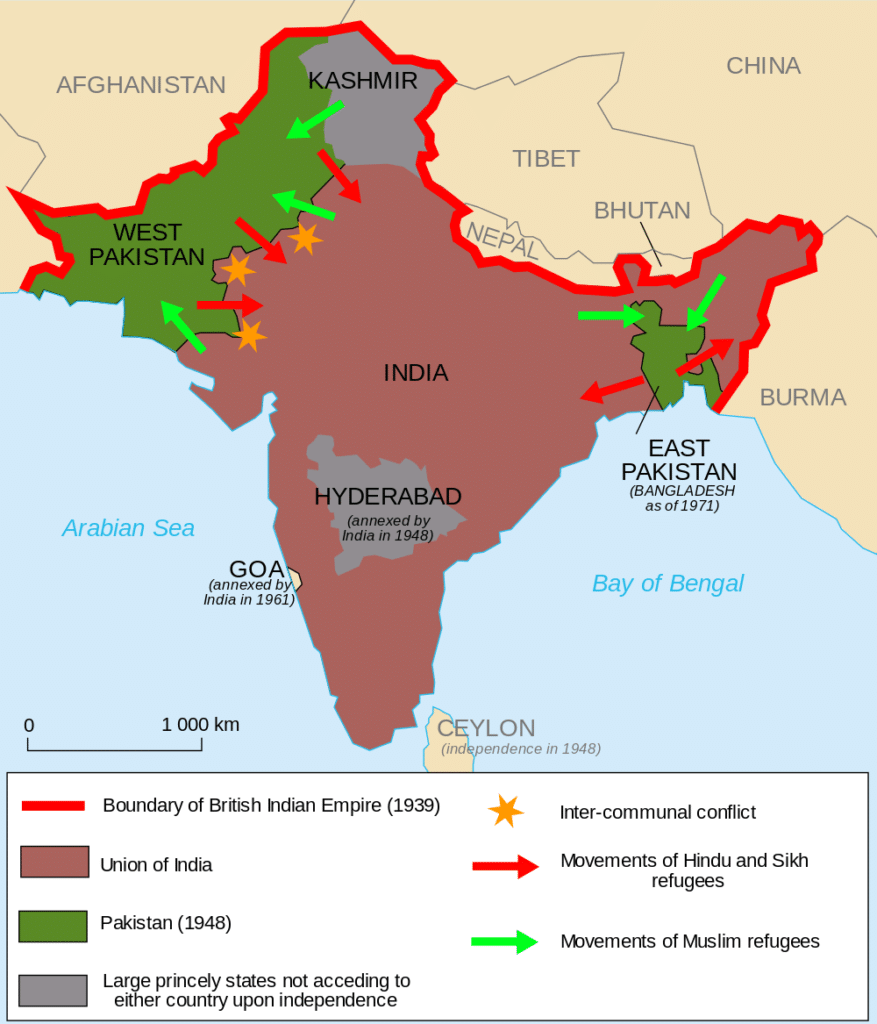
Ayub Khan regime
In 1958, General Ayub Khan took control of Pakistan in a military coup. Ayub Khan’s regime is often credited with kick-starting Pakistan’s industrialization process. The government launched a series of initiatives aimed at promoting industrial development, including the establishment of the Pakistan Industrial Development Corporation (PIDC) and the creation of tax incentives for businesses. Under Ayub Khan’s regime, Pakistan’s economy saw significant growth. The country’s GDP grew at an average rate of 6 percent per year, with the manufacturing sector growing at a rate of 9 percent per year. However, much of this growth was concentrated in the urban areas of the country, with rural areas and the agricultural sector being left behind.
In addition to promoting industrialization, Ayub Khan’s regime also introduced a number of social welfare programs aimed at improving the living standards of the country’s population. The government launched the Family Planning Program, which aimed to control population growth, and the Basic Democracy System, which sought to devolve power to local communities.History of Pakistan with the perspective of the economy by thefactspk.com
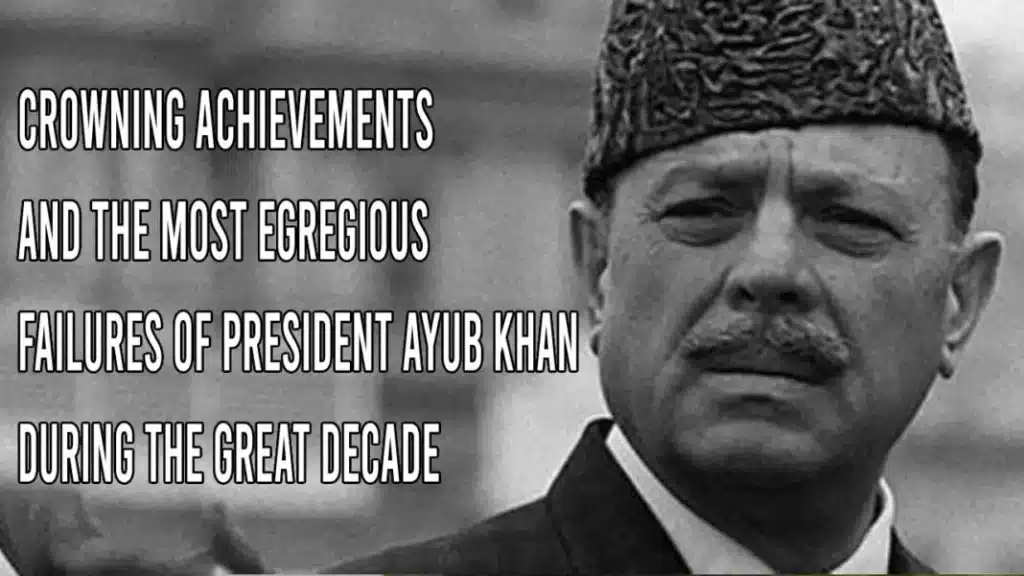
Zulfikar Ali Bhutto regime anti-american
In 1971, East Pakistan declared independence from Pakistan, becoming Bangladesh. This event had a significant impact on Pakistan’s economy, as the country lost a significant portion of its territory and population. In the aftermath of the war, Pakistan was left with a weakened economy and political instability. In 1972, Zulfikar Ali Bhutto took control of Pakistan following a general election. Bhutto’s regime is often credited with introducing a number of socialist policies aimed at redistributing wealth and promoting social justice. The government nationalized a number of industries, including banking, insurance, and large-scale manufacturing. Bhutto’s socialist policies were popular with the country’s poor and working-class populations, but they had a negative impact on the country’s economy. Many industries were poorly managed by the government, and corruption was rampant. The nationalization of industries also led to a lack of investment and innovation in the private sector.History of Pakistan with the perspective of the economy by thefactspk.com

General Zia ul Haq Amazing Regime
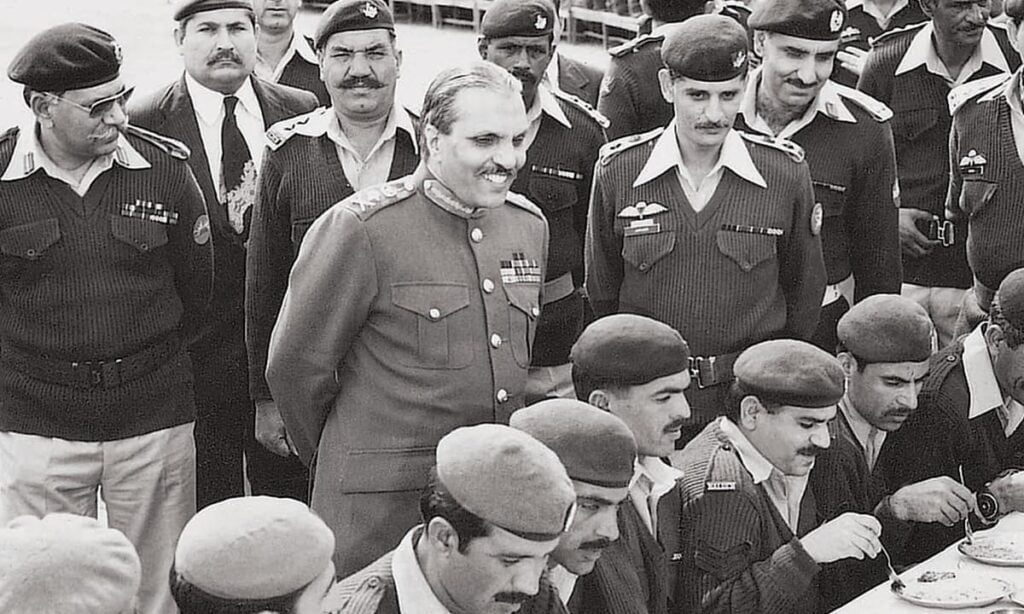
Who came to power in a military coup in 1977? At the time, Pakistan’s economy was struggling, with inflation soaring and foreign exchange reserves plummeting. General Zia’s economic policies focused on stabilizing the economy and promoting growth through a combination of austerity measures and investment in key sectors. One of the most significant steps taken during Zia’s regime was the liberalization of the economy. The government introduced market-oriented policies, deregulating many sectors and opening up the economy to foreign investment. This move led to increased competition and a boost in economic growth. Zia’s government also made significant investments in agriculture, which was the backbone of the Pakistani economy at the time. The government introduced new technologies and techniques to increase productivity and modernize the sector. History of Pakistan with the perspective of the economy by thefactspk.com
This move led to increased agricultural production and exports, which boosted the country’s foreign exchange reserves. Another notable aspect of Zia’s economic policy was the emphasis on Islamic banking. The government introduced Islamic banking laws, which led to the establishment of Islamic banks and financial institutions in the country. This move helped to mobilize savings and promote investment in the country. However, Zia’s regime was also marked by political turmoil and military rule. The government’s focus on economic stability came at the expense of political freedom and civil liberties. Zia’s strict policies, including censorship of the media and the suppression of political opposition, had a negative impact on the country’s long-term economic prospects.
Despite these challenges, Zia’s economic policies laid the foundation for future economic growth in Pakistan. The liberalization of the economy and investments in key sectors helped to stimulate growth and increase productivity. Today, Pakistan is a rapidly developing country with a diversified economy, and the seeds of its economic growth can be traced back to the policies implemented during the Zia ul Haq regime.
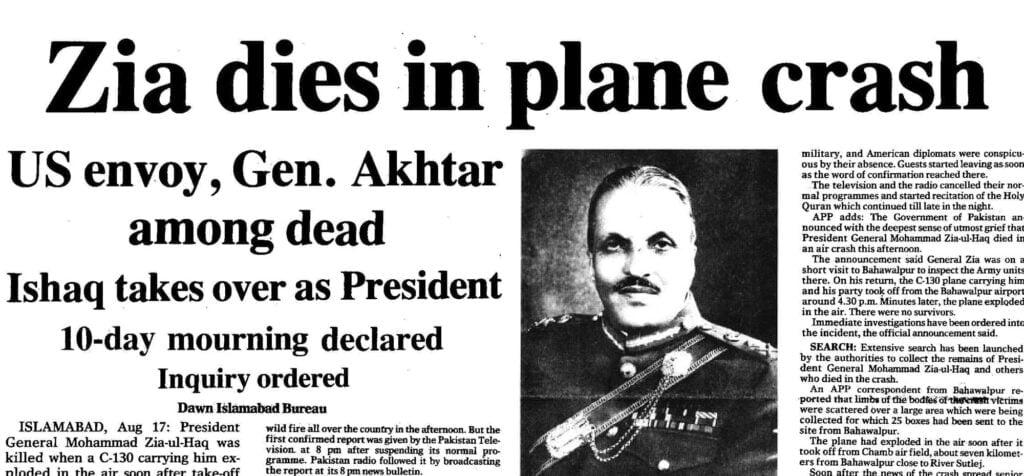
Pervez Musharraf regime
Pakistan, from 1999 to 2008, was a period of significant economic growth and reform in the country’s history. While his tenure was marked by political instability and controversies, his government’s economic policies helped to transform Pakistan’s economy from an agrarian-based one to a modern, service-based economy. Musharraf’s government introduced several economic reforms, including the privatization of state-owned enterprises, the deregulation of industries, and the liberalization of trade. These policies helped to attract foreign investment and increased economic growth, with the economy growing at an average rate of 7% during his regime. One of the most significant achievements of Musharraf’s government was the reduction of Pakistan’s external debt.
The country’s debt-to-GDP ratio, which was at 98% when he came into power, was reduced to 56% by the end of his tenure. The government also introduced a poverty reduction strategy that helped to lift millions of people out of poverty. Musharraf’s government also focused on infrastructure development, with the construction of new highways, motorways, and airports, which helped to improve connectivity within the country and boost trade. The government also introduced initiatives to improve the energy sector, such as the construction of new power plants and the privatization of state-owned energy companies.
However, Musharraf’s regime was not without its controversies. The government’s close ties with the United States and support for the War on Terror led to increased militancy and terrorism within Pakistan, which had a negative impact on the economy. The country also suffered from corruption, which undermined the government’s efforts to improve governance and transparency. Overall, Pervez Musharraf’s regime in Pakistan was a period of significant economic growth and reform, with the government introducing policies that helped to modernize the country’s economy and reduce poverty. However, the government’s controversial policies and political instability marred its achievements, and Pakistan still faces significant challenges in terms of corruption, governance, and terrorism.History of Pakistan with the perspective of the economy by thefactspk.com

Mohtrama Benazir Bhutto regime
The period of Mohtrama Benazir Bhutto’s regime, from 1988 to 1990 and then from 1993 to 1996, was a crucial time for Pakistan’s economy. Benazir Bhutto was the first female Prime Minister of Pakistan and the first female leader of any Islamic country. Her regime was marked by various economic policies aimed at improving the country’s economic situation. When Benazir Bhutto became the Prime Minister in 1988, Pakistan was facing severe economic challenges.
The country was heavily indebted, and its economy was stagnant. During her first regime, she implemented various policies aimed at stabilizing the economy. She introduced structural reforms in the economy, privatized state-owned enterprises, and introduced an austerity program to reduce government spending. These measures helped stabilize the economy and reduced inflation. However, her regime was also marked by corruption allegations, which led to her dismissal in 1990. When She was re-elected in 1993, and during her second regime, she implemented various policies aimed at stimulating economic growth.
She introduced an investment-friendly economic policy, which attracted foreign investment. She also implemented various social welfare programs aimed at reducing poverty and improving the standard of living of the people. Benazir Bhutto’s regime also saw the beginning of the process of liberalization and deregulation, which paved the way for the growth of the private sector. The telecommunications sector was opened up to private investment, and this led to the rapid growth of the sector. The banking sector was also deregulated, and this led to the growth of Islamic banking in Pakistan. Despite these measures, the economic situation in Pakistan remained challenging during Benazir Bhutto’s regime. History of Pakistan with the perspective of the economy by thefactspk.com
The country continued to face high levels of debt, and the economy remained heavily reliant on agriculture. However, her regime did lay the foundation for future economic growth, and many of the policies she implemented laid the groundwork for the economic reforms that were implemented in later years. In conclusion, Benazir Bhutto’s regime was a crucial period in Pakistan’s economic history. Her policies aimed at stabilizing the economy and stimulating economic growth helped lay the foundation for future economic development.




















